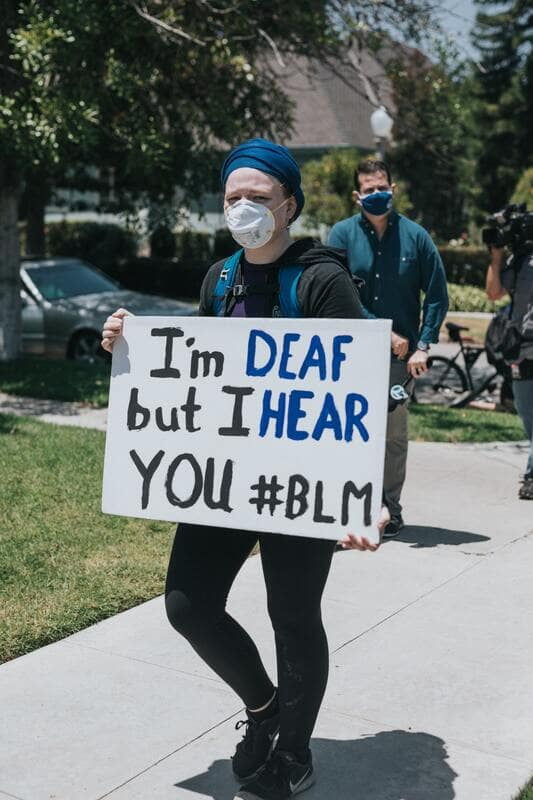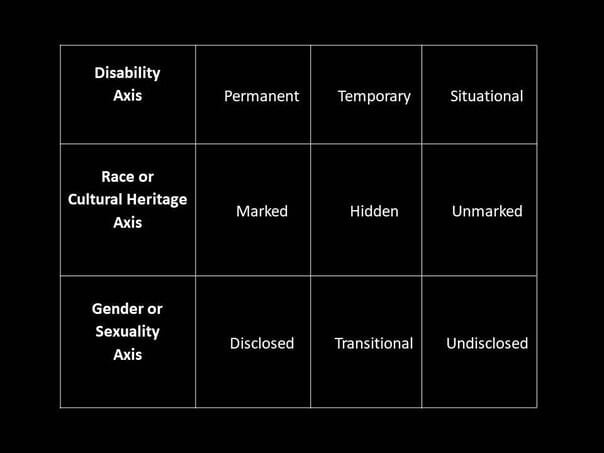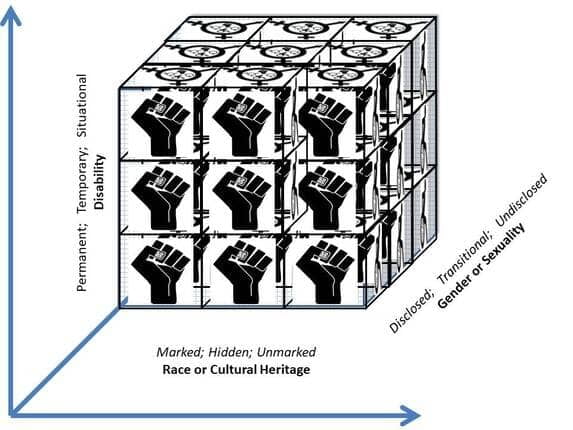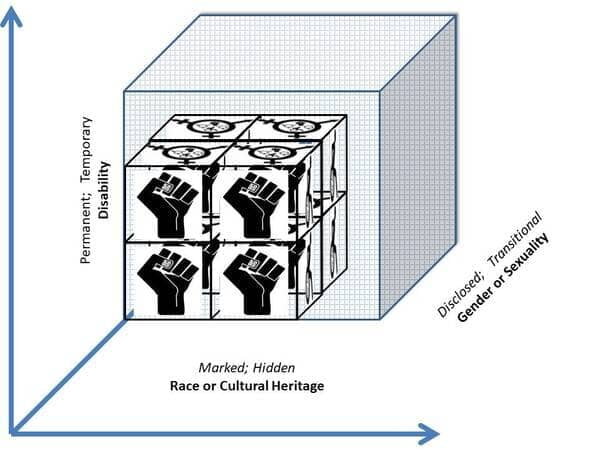In science and technology studies, the jury is still out about the utility of operationalizing design thinking and, in particular, the mode of empathy as good practice for making inclusive designs. Communications scholar Lily Irani (2018) and historian Lee Vinsel (2018) suggest that design thinking collapses the variety and complexity of design activities and theories into simple marketing and commercialization tools.
Irani (2018) further points out that design thinking is primarily interested in distinguishing the next wave of innovative capitalist work from the recent past of mathematics-driven innovation. She demonstrates that this bright line is drawn by using racist and xenophobic language to naturalize mathematics skills as inherently natural to Asians, and using global intellectual property law to preserve the (elite white) American design advantage.
Under design thinking discourse, Asians and Asian Americans' mathematical skill becomes (like the physical prowess of enslaved Black Americans) a thing to be owned or traded but not valued or invited into full citizenship. Design thinking's stratification of occupational status by race justifies the white economic nationalism that Irani argues has characterized US-led global intellectual property law since the 1990s. It also further diffuses the casual racism of individual designers (see Amrute 2020).
Cynthia Bennett and Daniela Rosner (2019) are equally skeptical of design thinking, particularly its emphasis on empathy. In design thinking, empathy is made available to designers through an immersive experience or simulation of user experiences. This shallow version of empathy, unfortunately, gives undeserved confidence to the designer. In the case of designers attempting to empathize with persons with disabilities, the result is devaluing and discounting their lived experience as users and as potential designers (Bennett and Rosner 2019).
Vinsel (2018) humorously compares this important design thinking mode to the instruction he received in his first year writing class to "consider your audience." Meanwhile, Bennett and Rosner join Irani in her concern that the mode of empathizing does not have the feminist sensibility it purports to contain.
As an avowed feminist who takes my colleagues' critiques seriously, I still find myself very fascinated by the persona spectrum. This method of developing empathy for various potential user motivations was developed by Kat Holmes when she was at Microsoft. There is a whole free toolkit you can download and use.
I really like the persona spectrum because Kat Holmes is flipping the "design thinking" script on its head. The status quo design class teaches the STEAM professional to design for the "normal" or "average" user and ignore the "edge" cases. Instead, Holmes asks in her book, what if there is no such thing as normal?
Perhaps Holmes is alluding to the many ways that a single human body might change to be physically or mentally able-bodied or disabled over a period of time (thanks to a separate conversation with Eileen Clancy for this insight). Therefore, disability can be situational, temporary, or permanent. But Holmes' book does not just touch on issues of equity and justice for persons with disabilities.
Holmes also describes inequities built-into status quo design for the "normal" user where expressway design propagated anti-Black racism. She includes an interview with a black woman architect native to Detroit, Michigan: Tiffany Brown shared how Robert Moses' urban planning annihilated the thriving, middle-class neighborhood called "Black Bottom."
Robert Moses' vision of U.S. expressway design is an example of structural racism in infrastructure design. His desire to replace what he saw as so-called inner-city slums with modern and convenient expressways for suburban travelers seems innocent on the surface. However, this was covert racist talk for eradicating thriving middle and lower class Black and immigrant communities.
For example, Amanda Phillips (2019) writes that Robert Moses' vision for Baltimore, Maryland, destabilized the middle-class Black neighborhood of Harlem in west and central Baltimore to create a road to nowhere (I-170). Likewise, according to Robert Mohl (2002) Robert Moses' consulting work in New Orleans, Louisiana, demolished the stable Creole neighborhood of North Claiborne to create I-10 in the city center.
In both examples, white, suburban, affluent communities successfully navigated a sometimes byzantine bureaucratic city government to prevent these expressways from being built in their neighborhoods. Still, they were happy to benefit from city-center access after Robert Moses' vision destroyed Black communities. These affluent white families were the "normal" users that Robert Moses' vision encompassed. In contrast, Black people and poor people were the "edge" cases.
Holmes asked Brown, "How does a designer shape inclusion?" Brown answered with a Latin phrase that she attributed to the disability rights movement "Nihil de nobis, sine nobis," or "Nothing about us without us." Holmes's emphasis on design "with and for" could be called an attempt to return feminist sensibility to a vacuous "design thinking" method package. Participatory design, co-design, and other such methods might be used in place of immersive simulations to inject the lived experience of users – whether racial or ethnic minorities, disabled, or LGBTQIA – into creating more inclusive designs. However, this has to be done carefully, iteratively, and in a spirit of collaboration, uplifting the most marginalized voices (see Costanza-Chock 2020).
Otherwise, as Bennett and Rosner (2019) uncovered, it risks the designer being complicit in stealing the authority of these voices. In addition to credit and authority, the designer should consider other issues of privacy, status, and reciprocity. Cultural anthropologists and sociologists conducting qualitative research have long been thinking about these power dynamics, especially those of us who stand with our interlocutors whom we also study up, down, sideways, and through.
Yet, the emphasis of design thinking on creating quick actionable prototypes is highly in tune with a capitalist emphasis on being efficient with time and increasing economic value (Delvenne and Macq 2020).
When I describe the importance of participatory methods to folks in BigTech industries, a frequent question is "how much time will that take?" Some are embarrassed by the missteps of some of their user experience contractors who conduct unethical (or at the very least insensitive) research with potential users from marginalized populations. However, to these industry professionals, design thinking seems useful. Simultaneously, participatory design research seems too slow and too expensive to be realistically incorporated into a product lifecycle.
With this feedback, I have recently introduced Holmes' persona spectrum focused around disability to my students at UMD Clark School. When I do so, I also ask the students to consider race and gender. My students are frequently unable to capture the variety of complex problems that folks with these identities might encounter in their persona spectrums. They are not well-versed in the hundreds of years of humanities and social science literature describing the histories and lived experiences of Blacks, women, or persons with disabilities.
Therefore, I am wondering graphically and playing around with the idea of creating an intersectional persona matrix. What do I mean by this? Intersectional is a way of describing how the several marginalized identities a single person may carry (e.g., in terms of disability, race, gender, sexuality, class, etc.) overlap in ways that cause an amplification of their negative effects.
In developing the term intersectional, legal scholar Kimberlé Crenshaw provided examples where laws arguably supporting anti-discrimination business policies did not, in fact, protect black women from discrimination in the workplace. This is because black women's identities involve both the disclosure of a marginalized gender, and the marking of a marginalized race. Because of amplified oppression of their personal identity, Black women encounter distinct forms of discrimination that non-Black women and Black men do not, and cannot, experience. Crenshaw was interviewed for a really excellent Vox article describing intersectionality. Since Crenshaw first coined the term for critical race theory in the 1980s, it has been used by legal scholars, sociologists, and other social scientists, and now has impacted more recent social movements such as #BlackLivesMatter.
Might an intersectional persona matrix extend Holmes' mantra of "build for one extend to all" with feminist standpoint epistemology's call to center the most marginalized? Could the result be the most interesting knowledge and useful insights concerning a problem or issue?
This intersectional persona matrix's goal would be to encourage designers to be explicitly attentive to identity, status and privacy and how it shapes motivations of users of products. Designers should also reflect on their own identity and status, and consider how to engage in reciprocal knowledge exchange and power exchange with marginalized populations. This helps them to avoid problematically extracting resources from already marginalized populations to further industrial wealth.
Encouraging sensitive attention, personal reflection, and reciprocal engagement is a tall order for one learning activity to implement. I am not sure how to implement reciprocal engagement into the intersectional persona matrix, I reluctantly discard that goal (for now).
My first attempt at an intersectional persona spectrum starts with Holmes' persona spectrum. In addition to the axis of disability (permanent, temporary and situational), I have added a second axis of race (marked, hidden, and unmarked). Therefore, now instead of three personas there are 3 x 3 or nine personas.
Race being marked means it is visibly or audibly discernable. Race is related to problems of colorism and environmental racism that pervade education, the criminal justice system, and the creation of infrastructure and equipment in the United States. Some Black people with lighter skin color hide their race to "pass" as white for the higher status and concurrent benefits. Likewise, in Japan some burakumin hide their lower caste heritage to pass as mainstream Japanese and therefore gain the higher status and concurrent benefits (Bondy 2012). Consequently, alternatives to race as an axis could be cultural heritage, class, or citizenship. The purpose of this second axis is to expand the persona spectrum to emphasize marginalized identities that people are born into and, because of structural inequality, find very difficult to change.
With this many personas, there is a lot of data to collect on many potential users. It might be simpler to consider a kernel of the intersectional persona matrix that focuses on the most oppressed identities. This kernel might exclude persons with situational disability, persons unmarked by race or cultural heritage, and persons whose gender or sexuality is undisclosed.
By shifting from the intersectional persona matrix to an intersectional persona kernel, we keep the emphasis of our data collection process centered on the most marginalized user identities while still potentially reaping the benefits of solving for one and extending for many.
If you are interested in iterating on this idea, I will make an open-access version available soon.
For the reasons outlined by my colleagues in science and technology studies, I do not support status quo design thinking empathy mode implementation of personas as average characters. However, since Holmes has broadcast her work, user experience designers are newly advocating for a focus on motivations instead of average characters. Perhaps the intersectional persona matrix might help designers initially consider human motivations that change according to identity as shaped by structures of power that oppress marginalized people.
References:
Amrute, Sareeta. 2020. "Bored Techies Being Casually Racist: Race as Algorithm." Science, Technology, & Human Values, March, 0162243920912824. https://doi.org/10.1177/0162243920912824.
Bennett, Cynthia L., and Daniela K. Rosner. 2019. "The Promise of Empathy: Design, Disability, and Knowing the 'Other.'" In Proceedings of the 2019 CHI Conference on Human Factors in Computing Systems, 1–13. CHI '19. New York, NY, USA: Association for Computing Machinery. https://doi.org/10.1145/3290605.3300528.
Costanza-Chock, Sasha. 2020. Design Justice: Community-Led Practices to Build the Worlds We Need. Cambridge, MA: MIT Press. https://mitpress.mit.edu/books/design-justice.
Delvenne, Pierre, and Hadrien Macq. 2020. “Breaking Bad with the Participatory Turn? Accelerating Time and Intensifying Value in Participatory Experiments.” Science as Culture 29 (2): 245–68. https://doi.org/10.1080/09505431.2019.1668369.
Holmes, Kat. 2018. "There’s No Such Thing as Normal.” In Mismatch: How Inclusion Shapes Design, 91–113. Cambridge, MA: The MIT Press. https://mitpress.mit.edu/books/mismatch.
Holmes, Kat. 2018. “With and For.” In Mismatch: How Inclusion Shapes Design, 63–76. Cambridge, MA: The MIT Press. https://mitpress.mit.edu/books/mismatch.
Irani, Lilly. 2018. "'Design Thinking': Defending Silicon Valley at the Apex of Global Labor Hierarchies." Catalyst: Feminism, Theory, Technoscience 4 (1): 1–19. https://doi.org/10.28968/cftt.v4i1.29638.
Mohl, Raymond A. 2002. “The Interstates and the Cities: Highways, Housing, and the Freeway Revolt.” Civil Rights Research. Washington, D.C.: Poverty & Race Research Action Council. https://www.prrac.org/pdf/mohl.pdf.
Phillips, Amanda Kirsten. 2019. Infrastructural Imaginaries: Highways and the Sociotechnical Production of Space in Baltimore. Blacksburg, VA: Virginia Tech. https://vtechworks.lib.vt.edu/handle/10919/87534.
Schroeter, Emerson. 2020. “User Persona Spectrums: What They Are and How to Use Them.” January 27, 2020. https://careerfoundry.com/en/blog/ux-design/persona-spectrums/.
Vinsel, Lee. 2018. "The Design Thinking Movement Is Absurd." Medium (blog). November 26, 2018. https://medium.com/@sts_news/the-design-thinking-movement-is-absurd-83df815b92ea.
Williams, Logan D. A. 2018. “Mapping Superpositionality in Global Ethnography.” Science, Technology, & Human Values 43 (2): 198–223. https://doi.org/10.1177/0162243917711005.




